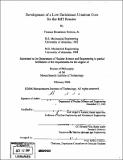Development of a low enrichment uranium core for the MIT reactor
Author(s)
Newton, Thomas Henderson
DownloadFull printable version (51.06Mb)
Other Contributors
Massachusetts Institute of Technology. Dept. of Nuclear Science and Engineering.
Advisor
Mujid S. Kazimi.
Terms of use
Metadata
Show full item recordAbstract
An investigation has been made into converting the MIT research reactor from using high enrichment uranium (HEU) to low enrichment uranium (LEU) with a newly developed fuel material. The LEU fuel introduces negative reactivity due to absorptions in 238U, which need to be compensated by higher initial content of 235U. Given that the new fuel density is much higher than the HEU density fuel, it is possible to obtain the necessary 235U content in the same core volume. A design of the MIT Nuclear Reactor is made using high density monolithic uranium-molybdenum fuel in an attempt to eliminate the reductions in neutron flux available to experiments due to the conversion to LEU fuel, as well as increasing the flexibility for meeting the needs of in-core experiments. The optimum configuration of fuel plates was made by varying the plate number and thicknesses and using a full-core model of the MITR for the Monte-Carlo transport code MCNP to determine the effect on flux and reactivity. In addition, the use of different moderator and fuel dummy materials as well as fixed absorbers was evaluated to optimize the neutron fluxes, reactivity and neutron spectrum available for experiments. The optimum reactor design consisted of the use of half-sized fuel elements made up of nine U-7Mo LEU fuel plates of 0.55 mm thickness with 0.25 mm finned aluminum cladding. This design also utilized solid beryllium dummies with boron fixed absorbers or solid lead dummies, depending on the in-core experiment flux and spectrum needs. Using MCODE, which links MCNP and the point depletion code ORIGEN, it was determined that the refueling interval of the LEU core would be about twice as long as the HEU core at the current power level of 5 MW. (cont.) Thermal-hydraulic calculations using the multi-channel thermal-hydraulics analysis code MULCH-II indicated that the peak power channel will remain below the Onset of Nucleate Boiling under all normal operating conditions as well as loss of flow conditions. In addition, using MCNP and the thermal-hydraulics/point kinetics code PARET it was shown that all reactivity coefficients were negative and that the LEU core could withstand a step reactivity insertion of $3.69 without reaching cladding softening temperature, thus increasing the allowable reactivity for an incore experiment. Finally, it is possible to use the proposed design to increase the neutron flux by increasing core power, but with a correspondingly reduced refueling cycle length.
Description
Thesis (Ph. D.)--Massachusetts Institute of Technology, Dept. of Nuclear Science and Engineering, 2006. Includes bibliographical references.
Date issued
2006Department
Massachusetts Institute of Technology. Department of Nuclear Science and EngineeringPublisher
Massachusetts Institute of Technology
Keywords
Nuclear Science and Engineering.